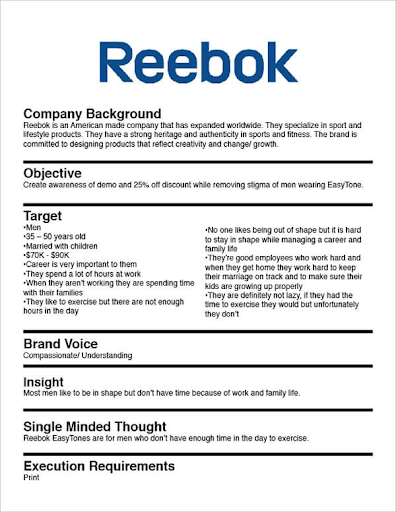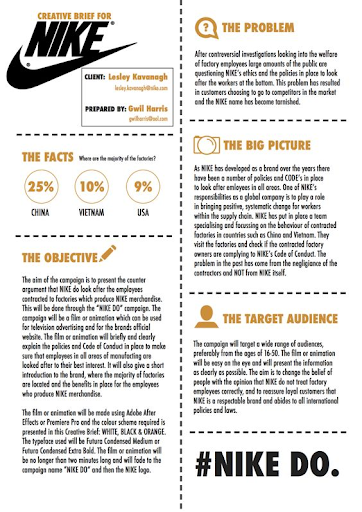A design brief is an essential part of the design process, as it provides you and your designer with a clear direction for the project. It should include design goals, objectives, target audience, budget constraints, design preferences, and any other information that will guide the design process. By providing this information upfront, you can help to ensure that your project is on track and that the design meets your expectations.
It also allows you to express any design preferences or ideas, so that your designer can take those into account when creating their design concept. Finally, it enables both you and your designer to have a clear understanding of what’s expected from the project, ensuring that everyone is on the same page.
Creating a design brief template can help ensure that designers have all of the necessary information for the design project. A design brief should include design goals, design preferences, target audience, budget constraints, and any other information that will help guide the design process.
Table of Contents
What is a Design Brief?
A design brief is a document that outlines the requirements, expectations, and objectives of a design project. It is one of the most valuable tools for successful project management as it provides clear direction on what needs to be done. The well-written design briefs will contain all the necessary information about design projects such as the project scope, budget, core details, client’s target audience, and design goals.
- An example of a design brief can be a mobile application design brief. It should outline the purpose of the app, its target audience, and the key features that make it stand out among other existing apps.
- It should also include the timeline for development and any additional information that is necessary to help guide the design process. Additionally, it’s important to consider how users will interact with the app – what kind of navigation do they need, what gestures should be used, and which functions are most important. All of this will help shape the user experience and ensure that users can get the most out of the app.
- Finally, it’s also important to consider how the design elements will work together – colors, typography, graphics, etc. – to create a cohesive look and feel. By taking all of these elements into account, a design team can create an app that meets the goals set out in the brief. Ultimately, creating a successful mobile app requires thoughtful consideration of all aspects of its design.
It should also include any design ideas that the client may have. By outlining all these key components, a design brief can help ensure that all stakeholders are on the same page and working towards the same end goal. The design process begins with an initial meeting between the designer and client to discuss the project in more detail and to agree on the design brief. This ensures that everyone involved in the project is working from the same design plan and that all expectations are met.
Why do designers need a design brief?
It’s the foundation of any design project. A design brief outlines the project overview, design goals, and any valuable project management tools that will help ensure a successful outcome. Having a well-written design brief is essential to having a successful design project.
It allows designers to gain clarity on what they need to do and how much time they will have to do it. It also outlines the design objectives, budget, and timeline which helps designers to manage their time effectively.
Additionally, a design brief serves as an important communication tool between the designer and their clients. By having a detailed design brief in place, both parties can be on the same page when it comes to expectations and design goals. A design brief not only helps to get everyone on the same page but also serves as a reference point throughout the design process.
Who should write a design brief?
A design brief should be written by anyone who is looking to outsource design work. It is important for design briefs to be as detailed and accurate as possible to accurately convey the design project’s goals, objectives, and requirements.
Writing a design brief helps to ensure that designers know exactly what is expected of them and that the design project is successful. A design brief should be written by anyone who needs design work done, whether it is a design agency or a design freelancer. Design briefs must be as clear and concise as possible to guarantee that the design project is successfully carried out.
What to Include in a Design Brief?
1) Project Overview
In the project overview section of your brief, you must articulate a precise explanation of what is needed and why. A compelling example would be to explain why design is needed and how the design could help solve a problem. To make this section better, why not ask yourself or your client a few questions? For example:
- What design are we building?
- What design challenges are you facing?
- What is the end goal of this design project?
- What design solutions have been tried before (if any)?
- What design challenges are we aiming to resolve?
2) Goals and objectives of the new design
When you are preparing a design undertaking and formulating your design brief, it is essential to designate what the desired outcome of the new design should be – whether that be yourself or your client. When creating a project proposal, it’s essential to understand the difference between goals and objectives. Goals are broad statements that outline the main idea behind your project, while objectives are more specific targets that measure success. To get an accurate understanding of what you’re aiming for in this endeavor, here are some questions to ask yourself:
- What design goals do you have for this design project?
- How will that design goal be measured in terms of success?
- What design objectives do you need to achieve to reach that design goal?
- What design challenges will the design team face and how will they be addressed?
3) Target market or audience
When you are creating a design brief, it is essential to identify who the design is intended for. The design target should be specified in terms of age, gender, location, and interests. Failing to define the design target can lead to design flops so be sure to do your research. To ensure design success, ask yourself:
- Who are we designing for?
- Where is this design going to be seen (print, digital, etc.)?
- What design elements will attract their attention?
- What design and UX best practices should be followed?
4) Project budget and schedule
Before any design project can even begin, it is important to determine the design budget and project timeline. Predefining these components allows you to design a more realistic design brief that accurately reflects your design aspirations. To make sure your design brief is up-to-date, consider the following:
- What design budget do we have for this project?
- What design timeline are we working with?
- Are there any design milestones that need to be met?
- What design resources or materials will be needed to complete the design project?
- Are there any design restrictions or design regulations we must adhere to?
5) Project deliverables
The design deliverables are the design assets required for design completion. This is the most important section of your design brief as it outlines everything you need to design and deliver for design completion. When designating design deliverables, consider the following:
- What design elements are required?
- What design formats should be included (vector, jpg, etc.)?
- Do you have any existing design assets or materials that can be used in the project?
- Are there any design elements that are not allowed?
- What design testing or design revisions might be needed?
6) Other relevant information
The design brief should also include any other design-related information that might be pertinent to the design project. This could include design techniques, design inspiration, design trends, design references, and design inspirations. This section should also include design notes or design feedback provided by the client or design team. Having this information readily available allows design teams to design a more informed design brief that accurately reflects design aspirations. To ensure design success, consider the following:
- Are there design techniques we should use?
- What design trends are currently popular in our design space?
- Do we need to research design references or design inspiration?
- What design feedback have we received from the client or design team?
- Are there any design notes that need to be added?
How to Write a Design Brief in 9 Steps?
1) Start with an overview of the business
Start by writing a brief introduction to the business and design project, summarizing what it is all about. This will provide context for the design brief and help you keep focused on the main objective of the design project. It helps to include the design project’s main objectives, audience, and design goals in this introduction.
2) Cover the scope
In this section, describe the overall design objectives. Include basic details such as deadlines, resources available, and any other relevant information that can help guide your design process. Covering the scope of the design project in a design brief will help ensure that the design work gets done on time and within budget.
3) Define the audience
Knowing who your target audience is very important when creating a design brief. Determine who will be seeing or experiencing your design work to create something that effectively speaks to them. Defining the design goals for the target audience will help you create work that resonates with them.
4) Understand the competition
Identifying what competitors are doing and how they’re approaching their design projects can help you come up with more effective design solutions. Understanding the design brief of your competitors can help you develop a design brief that stands out and is tailored to meet your specific design goals. Additionally, by understanding other design briefs, you can determine how to differentiate yourself from the competition.
5) Set specific goals
Define the design project’s primary goal and describe in detail how it will be achieved. This is important for creating an effective design brief that you, your design team, and the client can all refer back to. Setting measurable objectives allows you to track progress and ensure success.
6) Take inventory of what you already have
Identifying all materials that are already available such as design elements, logos, photos, etc., will make the design process go much smoother. It’s also helpful to include any design principles or design style guidelines that need to be adhered to.
7) Set the schedule
Outline a timeline of when each design element should be completed by giving yourself enough time but not too much. Setting a design brief will help ensure that you stay on track and remain focused throughout the design process. It should include objectives, ideas, design goals, materials, design elements, and deadlines for each design deliverable. This will help you stay organized and on task to deliver the final design product promptly.
8) Determine the budget
Consider any costs associated with the design project such as printing or shipping fees, software licenses, design resources, etc. Determining a realistic budget upfront can help you avoid any unexpected design costs down the line. A design brief should include information on your expected budget so that designers can design within your means. This will also help you narrow down the design options and get the best design for your budget.
9) Sum it all up
After you have gathered all the necessary details, review them together to make sure they accurately reflect the design project’s overall objectives and goals. Once everything is clear, you can begin your design work with a sense of direction and purpose. Once you are satisfied, write up a design brief that summarises the entire design process. This will help you keep track of what needs to be done and help you communicate your design vision to the rest of the design team.
Once everything is clear, you can begin your design work with a sense of direction and purpose. Creating an effective design brief template is essential in any design project, especially if it’s a new one. A design brief should include all the necessary information about the same project, from the project’s goals to the client’s expectations, so that all involved parties have a better understanding of what exactly is expected.
Design Brief Examples
1) Reebok
In the design brief, it is imperative to have clarity and detail, and Reebok adheres to these requirements. Although the brief may seem concise, the provided information is sufficient to bridge any gaps present.
Reebok places the primary emphasis on the campaign’s target audience. Additionally, it equips the executive team with comprehensive information, including the campaign’s main objective, brand voice, insightful inputs for the execution process, and the desired outcome requirements. This approach ensures effective communication and facilitates the successful execution of the campaign.
2) Nike
Nike prioritizes the campaign’s objective: demonstrating their commitment to the well-being of all employees. The top management team is provided with a concise and comprehensive explanation of the necessary steps to achieve the desired impact.
It is crucial to highlight that Nike places significant emphasis on the programs that will be utilized. Additionally, they provide specific details regarding the colors, fonts, and durations. Furthermore, Nike offers information regarding the problem that the collaboration aims to address and provides a comprehensive overview of the current situation.
Samples provided by Nike include detailed descriptions of the target, demonstrating their consideration and understanding of their customers’ needs.
Design Brief Template
Let’s have a look at a design project brief template to understand how you can create a design brief effectively –
1. Project Overview
What’s the project all about? Give us a brief, but clear picture so we can get on the same page.
2. Goals
What are we aiming to achieve with this project? Remember, setting clear and measurable goals can drive the project toward success.
3. Target Audience
Who are we designing for? Tell us about the demographics, their preferences, and what they like in a design.
4. Competitors
Who are your main competitors? Understanding them can help us create a design that stands out.
5. Design Requirements
What are the must-haves in the design? Whether it’s specific elements, colors, fonts, or a particular style, jot them down here.
6. Budget and Timeline
How much are you planning to invest in the design? And by when do you need it ready? This will help us plan things efficiently.
7. Contact Information
Who should we reach out to if we need more information or clarification about the project? Please provide the contact details here.
Remember, a comprehensive design brief ensures that everyone is on the same page and the project can move forward smoothly. So, let’s be as detailed as possible.
Design Brief vs Creative Brief
If you’re about to embark on an upcoming design project, it’s important to know the difference between a design brief and a creative brief. A design brief is a project management document that describes the client’s expectations for the same design project. It outlines the goals and objectives of the design project, who the design is for, what design components are required (e.g. layout design, typography, etc.), and the timeline for completion. A design brief is a great starting point for any design project as it serves as a foundational tool to guide the design process.
In contrast, a creative brief is more focused on the design approach for the project. It typically includes a description of the design concept, design style, and design elements that will be used. Creative briefs are used to guide the design process in a specific direction and ensure consistency throughout the design process.
After you have conducted the necessary research to align with your design brief, use a creative brief to gain an even further understanding of what will inspire and captivate your target audience. This approach ensures that all designs are tailored specifically to their interests and needs.
It’s important to note that a design brief template and a creative brief template are not interchangeable and should be used for different design projects. For every design project, start with a design brief to ensure that the project is managed effectively and efficiently from start to finish. Once you have the design brief in place, a creative brief can be used to ensure that all design elements meet your design goals and objectives.
Conclusion!
Now that you’ve gathered all the necessary information for your design brief, it’s time to put together a comprehensive design brief template that outlines the project’s goals, timeline, and relevant details.
A design brief template can help you keep track of all the details and make sure that your upcoming design project is a success! When creating your design brief, make sure to include a detailed description of all the elements that need to be included for it to be successful.
This way, you’ll have all the necessary information at your fingertips when you start work on your design project.
Liked this post? Check out the complete series on Marketing


